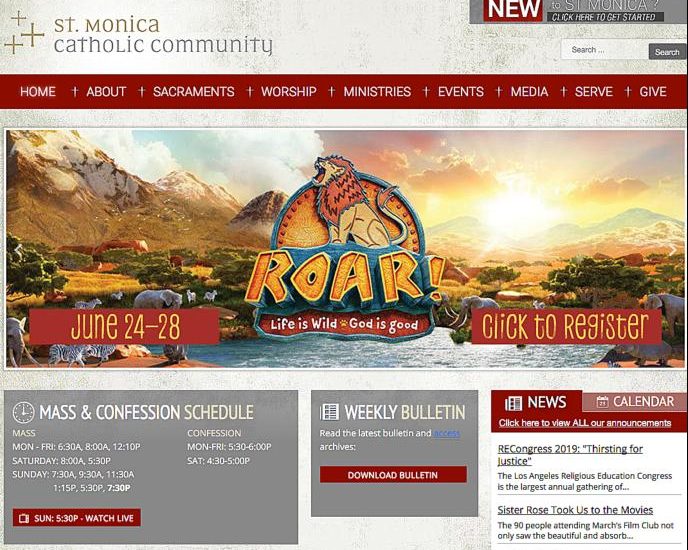
This is a screen grab from www.stmonica.net, website for St. Monica Catholic Community in Santa Monica, Calif. The parish livestreams its 5:30 p.m. Sunday liturgy over Facebook and livestream.com, and archives past weeks so that anyone can tune in whenever and wherever they might be, along with podcasts and special events. (CNS photo/www.stmonica.net)
As today’s technology increasingly connects us to news, information, entertainment and, most especially, other people, more Catholic parishes are discovering the benefits of using tech tools to connect current and potential members with the faith and each other.
Live streaming of weekly or daily Mass, podcasts, social media and apps are a few of the online formats where parishes can establish an identity and a mission.
(See related videos.)
Locally, these can be a particular blessing for the homebound, caregivers or those who are beginning to explore the faith. Globally, they are powerful tools to bring the word and the church forward in an increasingly secularly saturated landscape.
“We have to keep pace with the 24-hour news cycle and the tsunami of information,” said Merrick Siebenaler, director for marketing communications at St. Monica Catholic Community in Santa Monica, California. “It’s the only way the church and parishes are going to stay relevant, and it lets people know we’re here when you need us.”
[hotblock]
Although the mention of technology might make some think “complicated” and “expensive,” the reality of using it for effective, accessible parish life need not be.
More than 10 years ago, St. Monica livestreamed Christmas Eve Mass, relying on donated equipment and volunteers.
“It really was sort of homegrown, at first,” said Siebenaler.
Today, with more sophisticated equipment and a team of professionals and trained volunteers, the parish livestreams its 5:30 p.m. Sunday liturgy over Facebook and livestream.com, and archives past weeks so that anyone can tune in whenever and wherever they might be, along with podcasts and special events, such as the 2019 Lenten retreat.
Several “production values” drive the success of St. Monica’s effort: To keep its sacramental focus, the person operating cameras follows the flow of the Mass, not “reaction shots” of people in the pews. Viewers also expect consistency and quality.
“You cannot skip a single week,” said Siebenaler. “The second that happens, the drop off is exponential, and it’s very hard to get people back. Also, you have to start with the highest quality equipment you can afford and find professionals as mentors. Viewers will put up with video buffering, but not audio issues.”
Benefits of the hard work and effort reflect in comments posted by viewers that demonstrate direct engagement with the St. Monica community.
[tower]
“It’s the feedback that we get that is more valuable to us than the big data,” said Siebenaler.
At 11,000 families, St. Matthew Catholic Church in Charlotte, North Carolina, is the largest Catholic parish in the United States. It currently does not livestream liturgies, but it makes broad and creative use of diverse technologies in and out of the church, fostering welcome and accessibility even before people enter the sanctuary.
“So many ‘nones’ and Millennials drive by and wonder, ‘What’s going on at that big church?'” said Jim Alvarez, one of four communications department staffers and a 32-year veteran of television news. “They might be afraid to come in, so we might have to go to them. That’s where technology comes in.”
Alvarez and others use a combination of internet-based social media, including the church’s official YouTube channel, Matt tv (https://stmatthewcatholic.org/matttv) to communicate about parish events, news and other content. They also have a campus-wide closed-circuit TV system with screens throughout the parish’s several buildings that scrolls church activities and videos.
Alvarez said, “We run parishioners’ stories, the pastor talking about stewardship and the real stuff, like singing happy birthday to one of our priests. It builds connections. During Lent, we produced daily reflections that we put on social media. We reached about 50,000 people.”
Smaller parishes can also build an effective presence online at low cost, and doing so helps build fellowship among those involved.
“A YouTube channel doesn’t cost any money,” said Alvarez. “All you need is a smartphone and an inexpensive piece of edit software or a parishioner who has a Mac (computer) that comes with a free copy of iMovie. All of a sudden, you’ll see this involvement.”
Once inside the church, technology also enhances parish life and liturgy accessibility, particularly through universal design building elements.
[hotblock2]
“We have two giant high-def screens and an updated audio loop in the main sanctuary,” said Alvarez. “We do closed captioning and someone signs the 9 a.m. Mass. If we have a lector that needs to wheel up, there’s a ramp and a lift. You’re part of the whole — everybody’s welcome.”
For the parish that has yet to use technology, others further along, such as Alvarez, can offer guidance, as can current, tech-savvy parishioners.
“Everybody is carrying a camera right now,” said Alvarez. “Your priest, your staff, your parishioners. Teenagers and young adults, they’ll know how to get you on social media.”
And as the responses come in and a parish’s reach extends, the faith is shared in ever more profound ways.
“We would not be the same parish without livestream,” said Siebenaler. “It’s all about relationship and connection, it’s how people enter in. We’re meeting people where they are. Jesus did that — he met people on the road. He met people where they are.”



Share this story